Naturalist’s Notebook – July 16, 2016 to July 22, 2016
This week was another week full of humpback whale sightings. Reports from some of the trips feature descriptions of humpback whales feeding at the surface, while reports from others are filled with stories of breaching, lobtailling, and flipper-slapping. The reported feeding activity of humpback whale mothers is usually paired with the aerial activities of their calves.
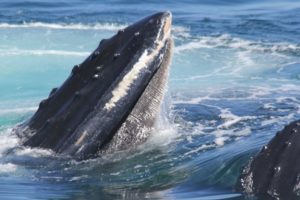
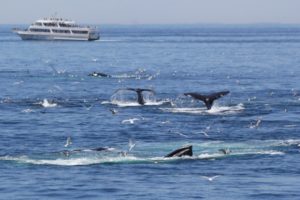
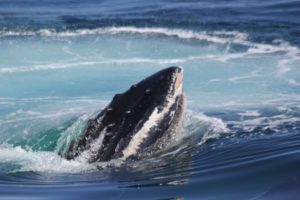
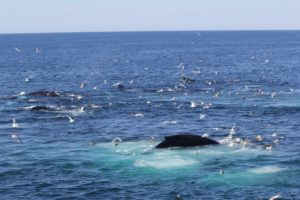
A few of the highlights from the week, like the rest of the week wasn’t just spectacular on its own, would have to include the sightings of nearly a dozen minke whales on July 16. These animals all looked like they were using the area in the same way that the humpbacks were. As a restaurant. They would surface quickly and take a few breaths before diving again. One of them was seen several times surrounded by birds at the surface. When we got a little closer, we could see why. This minke whale was feeding along the horizontal of the surface. It could be seen lunging along the surface, its mouth open enough that the tip of its rostrum and the tips of its flippers could be seen through the splashes its lunge was generating.
One of the coolest things I saw this week reminded me of babysitting my nieces and nephews. The Dolphin 8 found a group of four logging (resting) humpback whales that included a mother and calf pair. Twine’s calf was kind of fidgeting around and nudging into its mother. Eventually, it “woke” Twine up and the two of them began to spyhop and roll over. The whole incident put me in mind of trying to take a nap with a toddler. As I don’t have any of my own, I asked the passengers on the boat if that’s what it looked like to them. Most of the passengers with youngsters laughed. This is certainly not the first time I have thought of calves being very like toddlers. Many times, as you watch mothers and calves over a period of weeks, you notice that every day or so the calf seems to get farther and farther away from the mother while appearing to still be keeping close. It reminds me of going to the beach with my sister and her family. Every day the toddler would keep watching over his shoulders while walking away, testing whether or not he would get farther than the day before. At some point, one of his parents would call him back. Just like, at some point, the mother humpback would signal its calf and the calf would return to her side.
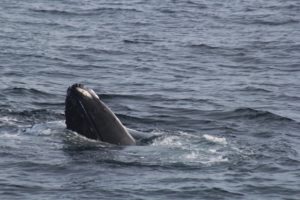
This week, Rapier and her 2015 calf were also seen. I have two comments to make about these sightings. First, humpback whale mothers usually afford their calf just one year of parental care before the two of them separate. It is unusual to see the two still together after that first summer. Unusual but not unheard of. While this might be the first time Rapier has stayed with a calf, she is not the only one that has. Scratch and Pepper have both spent two years with one or more of their calves. It is hard to say why that might happen, especially since we really don’t know what the driving force is behind the separation. Does the calf decide, or does the mother? Is it due to some environmental factor? One thought has been that it might be the result of males competing for access to the mother during the next mating season.
The second comment about this pair is that they have dorsal fins that are pretty much identical. And as the yearling is now so much closer to its mother’s size, it is more and more difficult to tell them apart without seeing the underside of the flukes.
There were also reports of encounters with curious humpback whale adults and calves this week. Humpback whales, as mammals, are very curious creatures. If they have nothing more important to be doing, they may approach vessels to check out the large body that is sharing a little bit of their environment. As you can imagine, this usually gets the attention of whalewatch passengers. It would be less than honest to say that captains and naturalists are any less excited by the prospect of a thirty five foot whale swimming under the boat and looking at it while we are looking back.
The really big news of the week was the sighting of a great white shark from the Dolphin X on July 22!
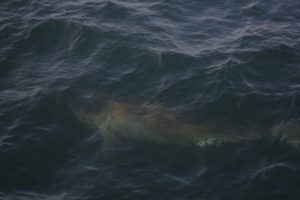
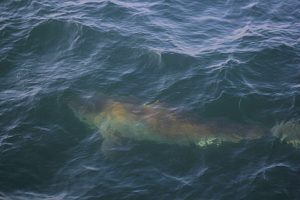
Charcharodon carcharias is a robust, torpedo-shaped shark. It is a very broad shark and usually is likened to having a truck pass beneath you. They are the largest of the sharks that feed on flesh and, while they prey on a wide variety of fishes, seals, seal lions, and sea otters, they have also been known to partake of whale carcass. At birth (they are ovoviviparous), Great Whites are about five feet long but, as an adult, they can measure up to twenty-one feet and weigh as much as three and a half tons. They are known to inhabit the coastal waters of temperate and subtropical zones but many times their presence goes unnoticed because they do not tend to swim close enough to the surface for their dorsal fins to break through unless the water is very shallow.
In recent years, due to the growing number of seals that have been using the beaches of Cape Cod as haul out colonies, there has been a great deal of interest in great whites. Yes, from year to year, the number of sightings of these sharks has been increasing, but, from year to year, the amount of time and effort put into looking for these sharks has also been increasing. I am not saying that there are not more sharks here than there were fifteen years ago. Scientific data suggests that there are. What I am saying is that if I spend ten hours looking for rabbits in the woods I am likely to find more rabbits than if I spend ten minutes. So don’t think that the waters around the Cape have become infested and that you are at all likely to see one from your whalewatch. Even with a growing food source, Great Whites are still rare, in part because they do not mature until the age of ten or twelve.
Carolyn OConnor, the lucky naturalist that saw the animal, rather nonchalantly describes just kind of glancing down beside the boat while waiting for the whales to resurface. You can feel the excitement in her description rise as she writes about realizing that the was a Great White Shark that close to the boat. Talking to her about it, in person, a few days later, she was still quite animated about the experience. I suspect that might prove to be one of those moments she never forgets.





